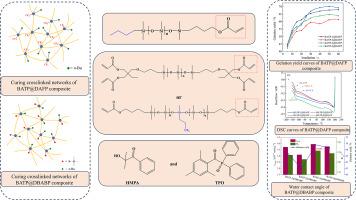Preparation and properties of UV-cured highly hydrophobic organosilicon composites
IF 5.1
3区 工程技术
Q1 CHEMISTRY, APPLIED
引用次数: 0
Abstract
This study focuses on the synthesis and characterization of silicone-based composite materials. Four α-(n-butyldimethyl)-ω-(acryloxybutyldimethyl)-terminated polydimethylsiloxanes (BATP) with varying molecular weights were prepared through anionic living polymerization, hydrosilylation, hydroxyl protection/deprotection, and esterification reactions. These BATP oligomers were blended with either a tetrafunctional acryloxy polysiloxane (DBABP) or a difunctional fluorinated polysiloxane (DAFP). The mixtures were subsequently UV-cured using a hybrid photoinitiator. The effects of UV curing time, blend composition, and structure on the structure and properties of the cured materials were investigated. Notably, all blends achieved cross-linking within 40 s of UV exposure. Composites prepared using BATP-3 oligomer with a number-average molecular weight of 3800 g/mol exhibited the highest gelation yield, approximately 70 %. Among the composites, the BATP-3@DAFP material demonstrated the lowest water absorption at 1.4 %, while the BATP-3@DBABP composite showed the highest water contact angle of 124.62°, indicating excellent hydrophobicity. This research highlights the potential of these silicone composites for applications requiring tunable surface and interface properties.

紫外光固化高疏水性有机硅复合材料的制备及性能研究
本文主要研究了有机硅基复合材料的合成与表征。通过阴离子活性聚合、硅氢化反应、羟基保护/去保护反应和酯化反应,制备了4种不同分子量的α-(正丁基二甲基)-ω-(丙烯氧基二甲基)端聚二甲基硅氧烷(BATP)。这些BATP低聚物与四功能聚硅氧烷(DBABP)或双功能氟化聚硅氧烷(DAFP)混合。随后使用混合光引发剂对混合物进行紫外光固化。研究了紫外光固化时间、共混物组成和结构对固化材料结构和性能的影响。值得注意的是,所有的共混物在紫外线照射后40秒内都实现了交联。以数平均分子量为3800 g/mol的BATP-3低聚物制备的复合材料胶凝率最高,约为70%。复合材料中,BATP-3@DAFP材料的吸水率最低,为1.4%,而BATP-3@DBABP材料的水接触角最高,为124.62°,具有良好的疏水性。这项研究强调了这些有机硅复合材料在需要可调表面和界面性能的应用中的潜力。
本文章由计算机程序翻译,如有差异,请以英文原文为准。
求助全文
约1分钟内获得全文
求助全文
来源期刊

Reactive & Functional Polymers
工程技术-高分子科学
CiteScore
8.90
自引率
5.90%
发文量
259
审稿时长
27 days
期刊介绍:
Reactive & Functional Polymers provides a forum to disseminate original ideas, concepts and developments in the science and technology of polymers with functional groups, which impart specific chemical reactivity or physical, chemical, structural, biological, and pharmacological functionality. The scope covers organic polymers, acting for instance as reagents, catalysts, templates, ion-exchangers, selective sorbents, chelating or antimicrobial agents, drug carriers, sensors, membranes, and hydrogels. This also includes reactive cross-linkable prepolymers and high-performance thermosetting polymers, natural or degradable polymers, conducting polymers, and porous polymers.
Original research articles must contain thorough molecular and material characterization data on synthesis of the above polymers in combination with their applications. Applications include but are not limited to catalysis, water or effluent treatment, separations and recovery, electronics and information storage, energy conversion, encapsulation, or adhesion.
 求助内容:
求助内容: 应助结果提醒方式:
应助结果提醒方式:


